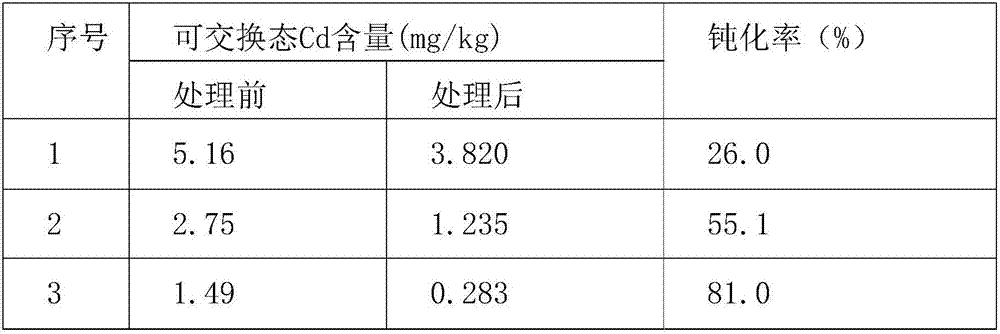Cadmium-contaminated paddy field soil microbial passivating agent
A technology of microorganism and cadmium pollution, applied in the field of biochemistry, can solve the problems of increasing the pH of the solution and reducing the bioavailability of Cd, and achieves the effects of excessive adsorption, good popularization and application value, and reduced bioavailability.
- Summary
- Abstract
- Description
- Claims
- Application Information
AI Technical Summary
Problems solved by technology
Method used
Image
Examples
Embodiment 1
[0024] Culture of Pseudomonas alcaligenes
[0025] Strains: Pseudomonas alcaligenes (DSM-50342 or DSM-19550).
[0026] Medium: Yeast powder 5.0g, KNO 3 1.0g, KH 2 PO 4 1.0g, MgSO 4 ·7H 2 O 1.0g, FeCl 3 ·6H 2 O0.05g, CaCl 2 2H 2 O 0.2g, trisodium citrate 5.0g, distilled water 1000mL, pH 7.2-7.4.
[0027] Cultivation: Inoculate 2 rings of slant strains into 100ml liquid medium, place at 30°C, shake at 120rpm for 2-3 days, then transfer to fresh medium according to 10% inoculation amount and expand culture for 48 hours, effective The number of bacteria is 1.0-2.0×10 9 cfu / g.
Embodiment 2
[0029] Cultivation of Bacillus subtilis
[0030] Strains: Bacillus subtilis (DSM-100605, or DSM-8565, or DSM-2109)
[0031] Medium: 5g peptone, 3.0g beef extract, 1000mL distilled water, pH 7.0-7.2.
[0032] Cultivation: Inoculate 2 rings of slant strains into 100ml liquid medium, place at 30°C, shake at 120rpm for 2-3 days, then transfer to fresh medium according to 10% inoculation amount and expand culture for 48 hours, effective The number of bacteria is 3.0-5.0×10 9 cfu / g.
Embodiment 3
[0034] Culture of sulfate-reducing bacteria
[0035] Sulfate-reducing bacteria strains: Desulfurization Enterobacteriaceae (DSM574) or Desulfovibrio Desulfurization (DSM 642), or a mixture thereof;
[0036] Medium: KNO 3 1.0g, K 2 HPO 4 0.5g, NH4Cl 1.0, Na 2 SO 4 1.0, CaCl 2 .2H 2 O 0.1, MgSO 4 ·7H 2 O 2.0g, sodium lactate 2.0g, yeast extract 1.0g, FeSO 4 ·7H 2 O 0.5g, distilled water 1000mL, pH 7.6-7.8.
[0037] Cultivation: inoculate 2 rings of slant strains into 100ml liquid medium, place at 37-40°C, 50rpm shaker and shake for 7 days, then transfer to fresh medium according to 10% inoculation amount and expand culture for 7-9 days , the effective bacterial count is 3.0-5.0×10 8 cfu / g.
PUM
 Login to View More
Login to View More Abstract
Description
Claims
Application Information
 Login to View More
Login to View More - R&D
- Intellectual Property
- Life Sciences
- Materials
- Tech Scout
- Unparalleled Data Quality
- Higher Quality Content
- 60% Fewer Hallucinations
Browse by: Latest US Patents, China's latest patents, Technical Efficacy Thesaurus, Application Domain, Technology Topic, Popular Technical Reports.
© 2025 PatSnap. All rights reserved.Legal|Privacy policy|Modern Slavery Act Transparency Statement|Sitemap|About US| Contact US: help@patsnap.com



